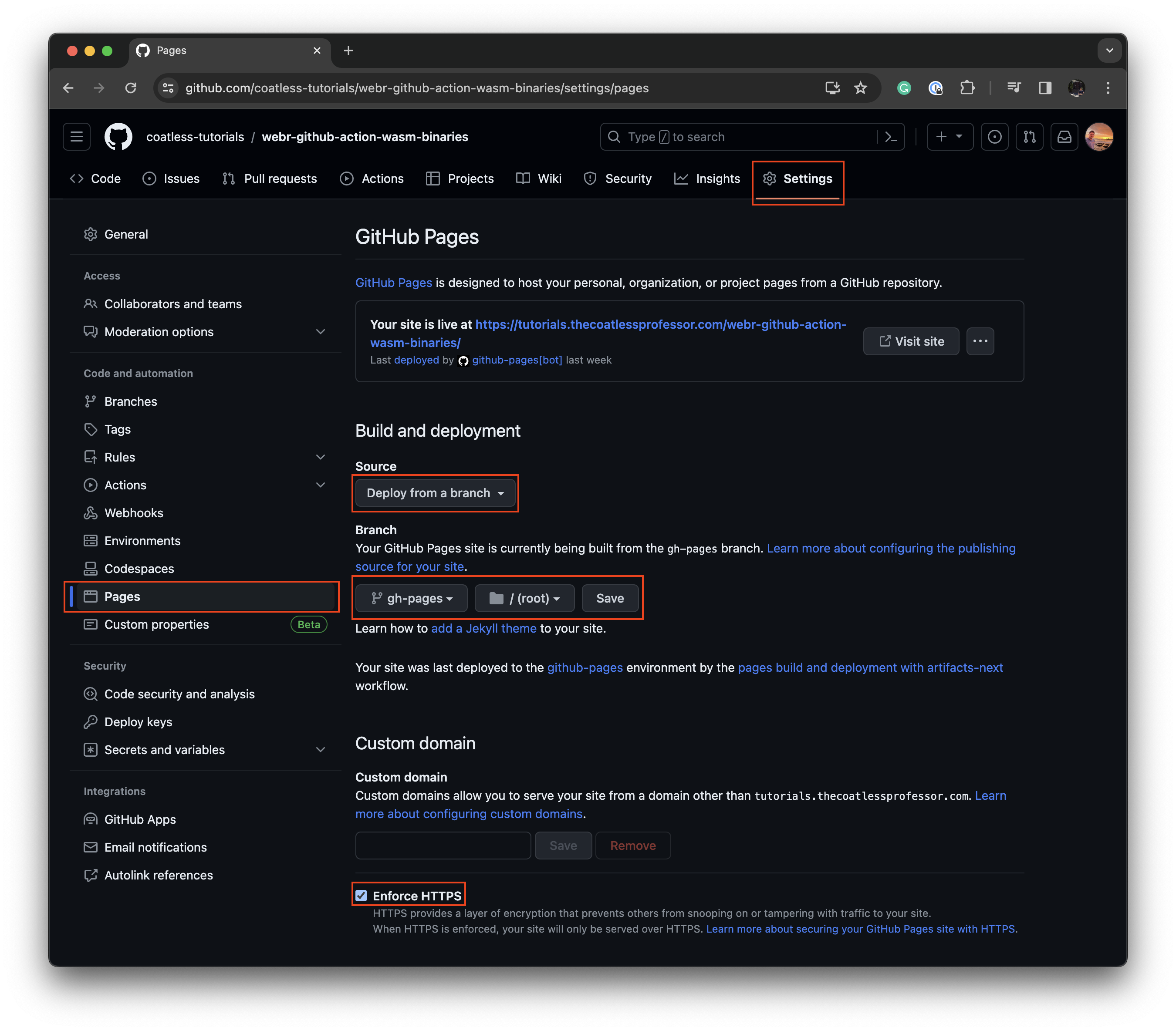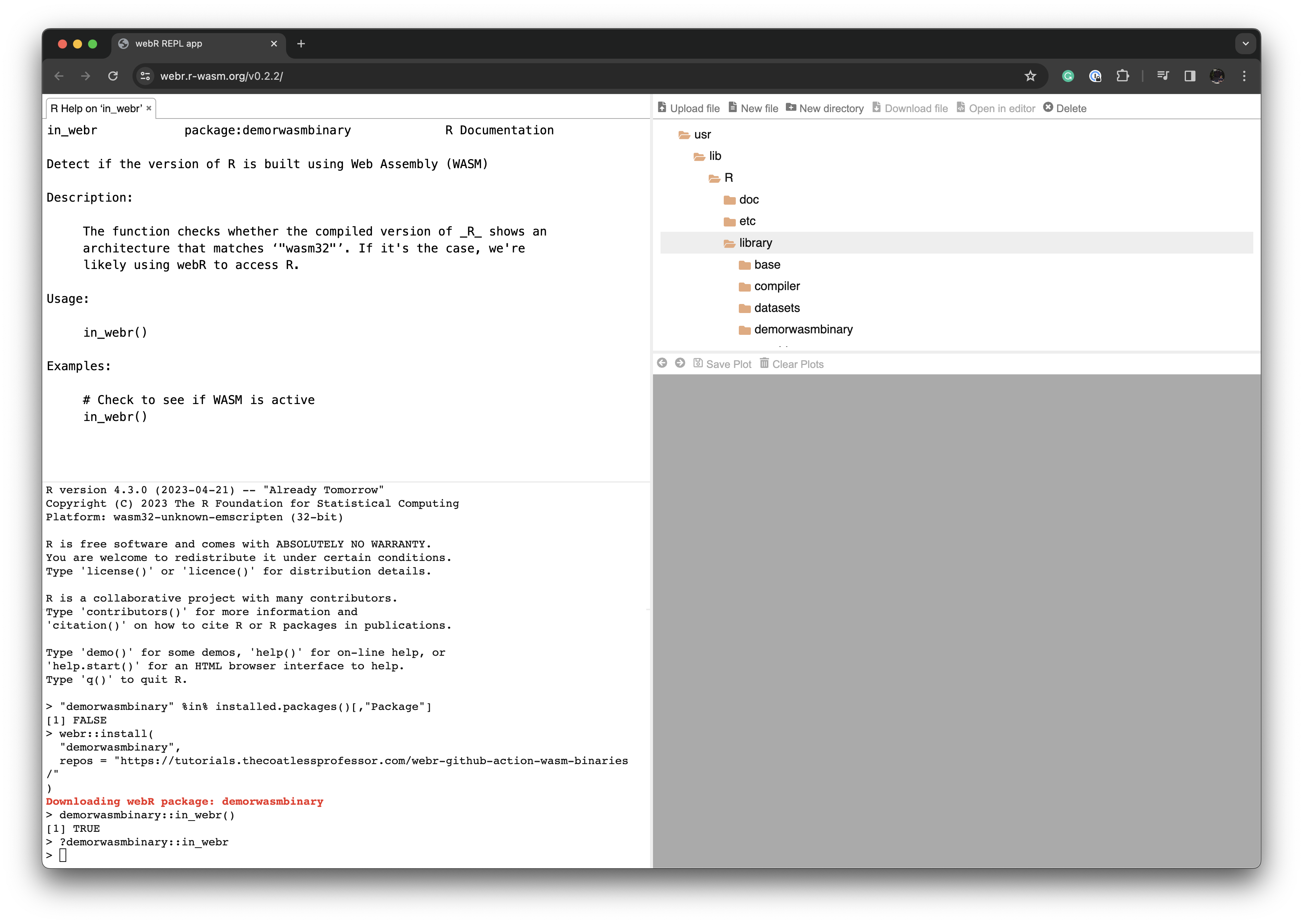Introduction
Welcome to this tutorial on automating separate build processes for compiling an R package for webR and creating a pkgdown website using GitHub Actions. In this guide, you will find sample GitHub Action workflows designed to generate developmental webR/R WASM Package binaries alongside a pkgdown website. If you’re eager to streamline the process of building and deploying your R packages for webR while also creating a pkgdown website, you’ve come to the right place.
This repository is part of a series exploring three different approaches:
-
Org-focused webR/WASM Package Repository without a
{pkgdown}website- This repository serves as an example implementation of the webR Project’s Build R packages using GitHub Actions documentation. It focuses on creating an organizational webR/WASM Package Repository without the inclusion of a pkgdown website that is meant to be triggered through workflow dispatches or changes to a
packagesfile. Explore this repository for insights into structuring your own organization-centric webR package repository using GitHub Actions.
- This repository serves as an example implementation of the webR Project’s Build R packages using GitHub Actions documentation. It focuses on creating an organizational webR/WASM Package Repository without the inclusion of a pkgdown website that is meant to be triggered through workflow dispatches or changes to a
-
Unified GitHub Action Deployment using artifacts of R WASM Package binaries and {pkgdown} website
- This repository introduces a unified approach to GitHub Action deployment by using artifacts. Unlike the previous strategy, this allows for the simultaneous deployment of R WASM binaries and the associated pkgdown website by using artifacts. This approach helps prevent a continuous increase in repository size. Explore this repository to understand how the use of artifacts can streamline your deployment process while maintaining a clean and efficient version control history.
-
Separate GitHub Action Deployment onto
gh-pagesbranch of R WASM Package binaries and {pkgdown} website [This repository]- This repository adopts a workflow approach familiar to R package developers using
usethis. It employs separate GitHub Actions for generating the R WASM package binaries and pkgdown website. The key aspect of this approach is the merging and deployment of both outputs through thegh-pagesbranch. This strategy enhances clarity in tracking file changes and provides a transparent view of the deployed content. Explore this repository to understand how this approach can streamline your R package deployment workflow.
- This repository adopts a workflow approach familiar to R package developers using
Another approach would be to use r-universe.dev to automatically build and supply R WASM package binaries.
Key Contents
Here’s a quick summary of what you can find in the repository:
-
.github/workflows/deploy-cran-repo.yml: A heavily modified version ofr-wasm/actions’ deploy-cran-repo.yml, leveraging ther-wasm/actions/build-rwasmaction to create R WASM packages andJamesIves/github-pages-deploy-actionto deploy the packages onto a GitHub Pages branch. -
.github/workflows/pkgdown.yml: Standard pkgdown GitHub Action fromr-lib/actions/examples/pkgdown.yaml. -
_pkgdown.yml: Usual configuration for a pkgdown website. -
DESCRIPTION: Contains usual meta data information for an R package. -
R/in-webr.R: A script designed to check if the R package is being run inside a webR environment.
Deployment Strategy
The deployment strategy for this repository involves pushing built R WASM Packages and the associated pkgdown website directly into the gh-pages branch. You can view the pushed webR package binary parts by looking at the gh-pages branch of the repository. Specifically, we can see binary package data bin/emscripten/contrib/4.3 and the package information in src/contrib. The other files form the basis for the pkgdown website. You can learn more about package repositories that are CRAN-like in the R Administration: 6.6 Setting up a package repository.
It’s essential to note that a potential drawback to this approach is the gradual increase in the repository size with each commit. This expansion occurs as the webR binary for the package, along with its dependencies, is stored in the gh-pages branch. On the positive side, utilizing version control tools allows for clear visibility into the changes between deployments.
Setup
For the setup, we’re going to aim to use {usethis} R package to enable GitHub Pages and retrieve a workflow for building R WASM packages.
Setup Github Pages on the Repository
We can enable GitHub pages directly from usethis with:
if(!requireNamespace("usethis", quietly = TRUE)) {
install.packages("usethis")
}
# Ensure GitHub Pages is set up
usethis::use_github_pages()Another option is directly enabling GitHub Pages on the repository by following:
- Click on the Settings tab for the repository
- Under “Code and automation”, select the Pages menu item.
- Under the “Source” option select Deploy from branch from the drop down.
- Under the “Branch” option, select the
gh-pagesbranch with the deploy directory of/ (root)and press Save. - In the “Custom Domain” settings, make sure that Enforce HTTPS is checked.

Example configuration of GitHub Pages
Setup the R WASM Package Build GitHub Action
Next, obtain a copy of the modified GitHub Action workflow that compiles the R WASM package binaries and deploys them onto GitHub Pages by committing into the gh-pages branch with the following R code:
# Obtain the modified version of the rwasm repo setup
usethis::use_github_action(
"https://github.com/coatless-tutorials/webr-github-action-wasm-binaries/blob/main/.github/workflows/deploy-cran-repo.yml"
)Or, you can re-create what usethis is doing by using:
# Create the GitHub workflows directory if not present
dir.create(".github/workflows", showWarnings = FALSE, recursive = TRUE)
# Download the GitHub Action workflow into the repository
download.file(
url = "https://github.com/coatless-tutorials/webr-github-action-wasm-binaries/blob/main/.github/workflows/deploy-cran-repo.yml",
destfile = ".github/workflows/deploy-cran-repo.yml"
)
# Block R build from including the GitHub folder
writeLines(
text = "^\.github$",
con = file(".Rbuildignore", "a")
)That’s it! Binaries will now be automatically built upon each new commit and published on the repository’s website served by GitHub Pages.
Accessing Binaries
In a webR session, access the built binaries using the repository’s GitHub Pages URL, for example:
https://gh-username.github.io/repo-nameDepending on where you are using the custom R WASM package binary, you can register this repository in different ways:
- Using the
reposkey inside of thequarto-webrextension; - Using
options()to set values for bothreposandwebr_pkg_repos; or, - Using the
reposparameter in eachwebr::install()call.
repos Document key in {quarto-webr}
With version v0.4.0 of the {quarto-webr} extension, the repository can be included by using the repos key in the document header:
---
webr:
packages: ['pkgname']
repos:
- https://gh-username.github.io/repo-name
filters:
- webr
---Specifying repo urls with options()
To define the location webR should search for in options(), we need to set both repos and webr_pkg_repos.
## Run once at the start of the session
# Specify where to search for the R WASM packages
list_of_repos = c(
"https://gh-username.github.io/repo-name",
"https://other-gh-username.github.io/another-repo",
"https://username.r-universe.dev",
"https://repo.r-wasm.org/"
)
# Set the repository URLs
options(
repos = list_of_repos,
webr_pkg_repos = list_of_repos
)
# Install the R WASM Package
webr::install("pkgname")[!NOTE]
This is different than the
reposoption one would usually set since webR only checks thewebr_pkg_reposkey; however, other R functions likeavailable.packages()check thereposparameter.
Specifying repos in webr::install()
The repos parameter may also be specified in the webr::install() command each time you need to install a package from a custom location:
webr::install("pkgname", repos = "https://gh-username.github.io/repo-name")
webr::install("pkgname", repos = list_of_repos)[!IMPORTANT]
Ensure the repository’s GitHub Pages website is available over
HTTPS(notHTTP). Verify this option in the repository’s Settings page under Code and automation > Pages > Enforce HTTPS.Otherwise, you might encounter an error:
Warning: unable to access index for repository http://gh-username.github.io/repo-name/bin/emscripten/contrib/4.3
Verify
Visit the webR REPL Editor (pinned to v0.2.2) and run the following:
# Check if package `{demorwasmbinary}` is installed
"demorwasmbinary" %in% installed.packages()[,"Package"]
# Install the binary from a repository
webr::install(
"demorwasmbinary",
repos = "https://tutorials.thecoatlessprofessor.com/webr-github-action-wasm-binaries/"
)
# Check if the function works
demorwasmbinary::in_webr()
# View help documentation
?demorwasmbinary::in_webrYou should receive:

Screenshot of the webR REPL editor showing how to download from repository outside of repo.r-wasm.org an R package binary